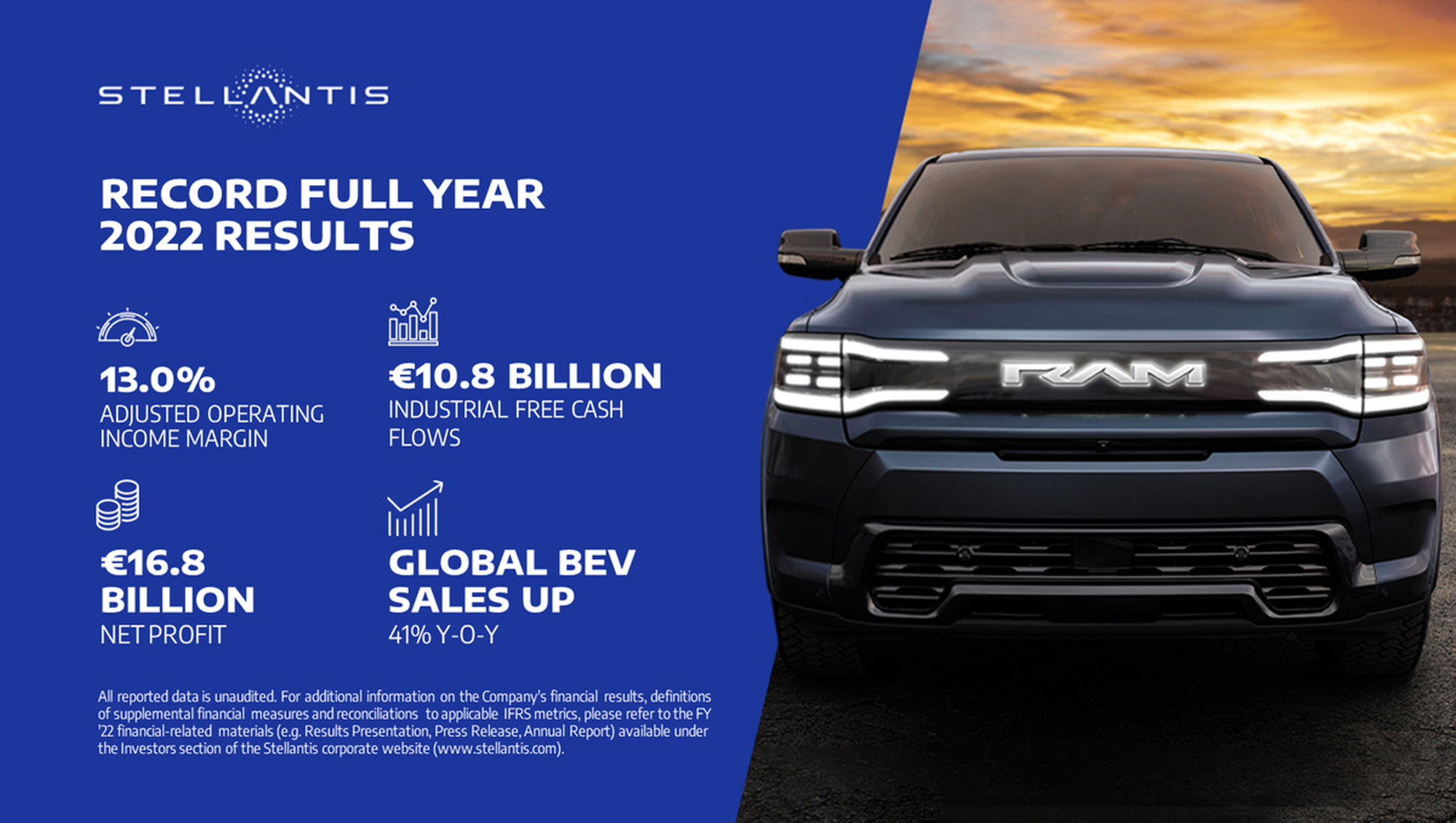
Stellantis has announced that it achieved a net income of €16.8 billion in 2022, generating a profit that is 26% higher than the previous year, marking two consecutive years of profitability.
While announcing its 2022 performance, Stellantis reported net sales of €179.6 billion, an 18% increase compared to the previous year, with adjusted operating income rising to €23.3 billion, approximating a growth of about 29% year-over-year. From this, a profit margin of 13% was secured, and net profit surged by 26% year-over-year to €16.8 billion.
Stellantis revealed its rapid growth last year in various areas such as electrification, software development, and vertical integration, indicating that it is quickly moving toward achieving its carbon-neutral strategy, ‘Dare Forward 2030’. Financially, the company aims to double its net sales to €300 billion by 2030 compared to 2021, while maintaining a double-digit adjusted operating income.
With plans to halve carbon emissions by 2030 compared to 2021 and achieve carbon neutrality by 2038, Stellantis reported an 11% reduction in carbon emissions across industrial sites and owned properties throughout 2022. Additionally, the company announced a target to reduce vehicle defect rates arising within three months of delivery by up to 30%, aiming for the top customer satisfaction rankings.
All major personnel procedures at the company are based on diversity, with plans to increase the percentage of female executives from the current 27% to 30% by 2025.
The global sales of Stellantis’ battery electric vehicles (BEVs) also demonstrated a 41% increase year-over-year, reaching 288,000 units, proving that electrification is accelerating. Currently, 23 types of BEVs have been launched in the global automotive market, with plans to increase this number to over 47 by the end of 2024 and over 75 models by 2030, aiming for cumulative sales of 5 million units.
In 2022, Stellantis ranked first in commercial BEV sales and second in overall BEV sales across the EU’s 30 countries, with the ‘Fiat New 500’ being the best-selling vehicle in Italy and the Peugeot ‘e-208’ leading electric vehicle sales in France. The Jeep ‘Wrangler 4xe’ was the most sold plug-in hybrid vehicle in North America, including the United States and Canada.
Stellantis also shared its achievements through collaboration in each core field. To ensure seamless battery supply, the company has confirmed the establishment of gigafactories in a total of five locations (three in Europe and two in the U.S.) in collaboration with Samsung SDI, LG Energy Solution, and Automotive Cells Company. Plans were also revealed to accelerate joint production of eVTOL (electric vertical takeoff and landing) flying taxis with startup ‘Archer’ and to acquire shares in hydrogen mobility global leader ‘Symbio’.
The software development at Stellantis has been made possible through close collaboration with Amazon, Foxconn, and Qualcomm, hiring over 1,500 software engineers, and employing around 700 individuals from software and data academies.
Development of Stellantis’s software platforms – STLA Brain, STLA Smart Cockpit, and STLA AutoDrive – is progressing smoothly. Road testing of prototypes is scheduled to begin in the second half of 2023, with technological production planned to start by the end of 2024. By acquiring the autonomous driving technology company ‘aiMotive’, Stellantis has enhanced its core capabilities in artificial intelligence and autonomous driving. With a 25% growth in the software sector’s growth strategy compared to 2021, the company is on track to achieve its target of €20 billion net income and a 40% overall margin by 2030. As of the end of 2022, Stellantis has operated a total of 13 million connected vehicles over the past five years, with a target of reaching 34 million by 2030.
Moreover, Stellantis’s record achievements are distinctly apparent by region. The net sales in the Middle East and Africa, South America, China, India, and the Asia-Pacific region—referred to as the ‘third engine’—increased by 34% compared to 2021, and total adjusted operating income contributions recorded a more than twofold increase to €3.8 billion.
Carlos Tavares, CEO of Stellantis, stated, “Stellantis has not only showcased the results of its efforts toward achieving the Dare Forward 2030 strategy alongside record performance, but has also proven how effective its electrification strategy has been in the European market.” He expressed gratitude to all employees and partners who contributed to a sustainable future, stating, “We have all the necessary conditions of technology, products, raw materials, and battery manufacturing to lead similar innovations in the North American region.”
By Lee Sang-jin (daedusj@autodiary.kr)

